Much like the western side of the 400-500 block of McMannen St., the eastern side developed with a first generation of ~1870s-1880s houses (most likely) of which many were supplanted by larger dwellings during the 1890s-1910s. Some of the earlier dwellings persisted on the east side into the 1960s
507 S. Mangum
507 S. Mangum started life as 133 McMannen St., which became 313 McMannen St., then 507 McMannen St. It was the house of William H Proctor and his wife Decie Proctor. Proctor is listed as a grocer at 112-114 North Mangum Street. By 1903, William C. Mangum, student is also listed.
The McMannen district's heyday was short-lived, and the merchants, lawyers, etc. had mostly moved on to newer fashionable districts by the 1910s. Most houses were already replete with boarders by the 1910s, or had become rooming houses.
Most survived into the 1960s, only to be torn down wholesale in the 1960s through the urban renewal program.
Looking south from the courthouse, 07.15.68. The area to the west of Roxboro (right side) had been completely cleared, and the freeway is under construction in the background. Demolition of the east (left) side of the street had not begun.
Hard to get perspective on this, but I believe it is looking southwest from near Dillard Street, 1968
Looking north from present-day Jackie Robinson, ~1969-70.
(Courtesy Durham County Library / North Carolina Collection)
Elkins Chrysler-Plymouth moved south from their former location at North Roxboro and Parrish Streets in a land swap for their former location, which was also demolished by urban renewal.
Elkins Chrysler under construction, looking east, 1968.
(Courtesy The Herald-Sun)
Looking northwest, 02.01.89.
Chrysler dealership, looking southeast, 2007.
Chrysler dealership, looking northeast, 2007.
Durham Freeway, looking southeast, 2007.
Most recently, the dealership was purchased by the Johnson dealership company, who made no secret that they were interested in unloading the property. They placed it under contract within the past few weeks, to Scientific Properties, who have stated only that they are interested in developing a "mixed-use project."
The Scientific Properties portfolio continues to grow: I've put together a quick-and-dirty overview map to show their projects, proposed and actual.
Given the projects on their plate, one has to think that the Elkins Chrysler parcel is land banking more than project at the moment. As much as I love adaptive reuse, I'm happy that SP is proposing new, mixed-use development downtown. This is exactly where it should go - on the scorched earth of car-dealership land. I think we've got awhile to wait to sound my familiar streetscape refrain, so I'll just note that it's thrilling to think of some city re-occupying the urban renewal moonscape.

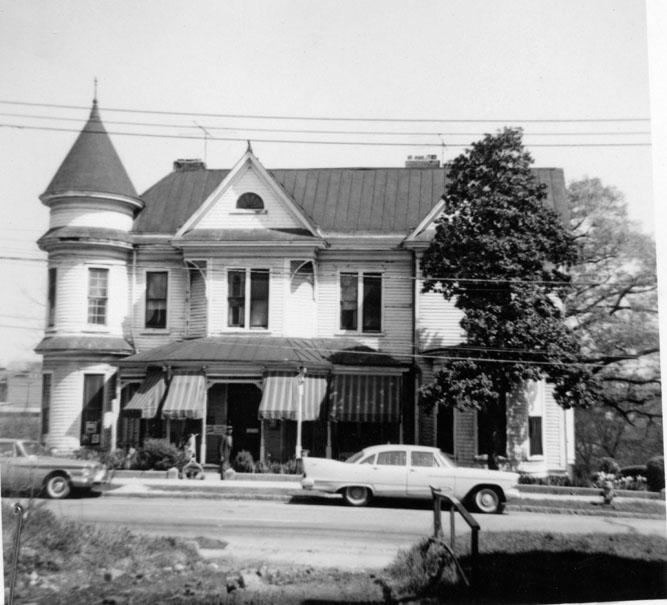
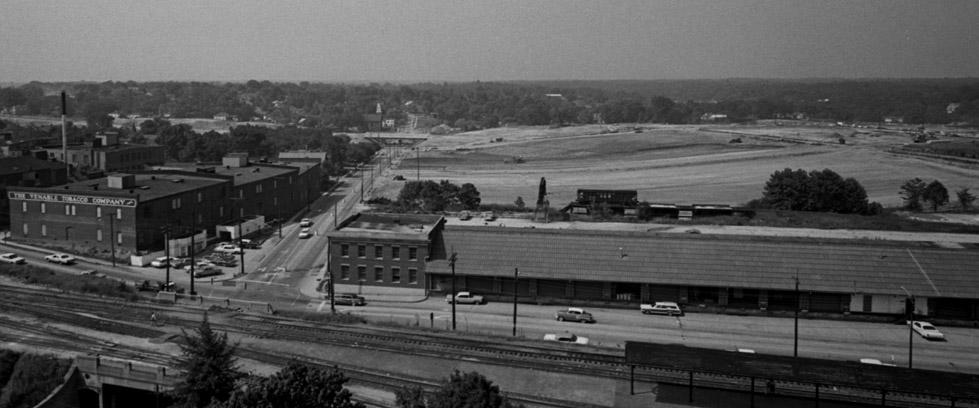
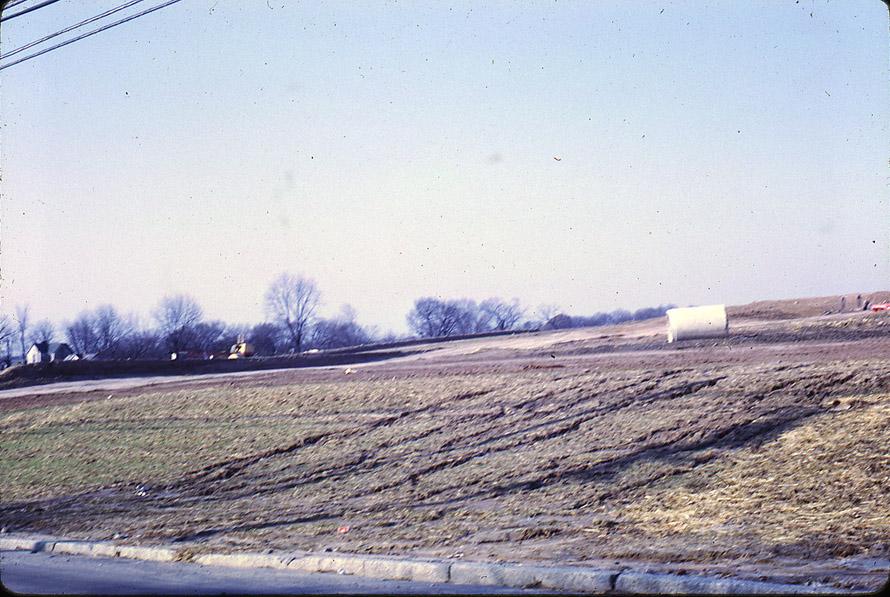

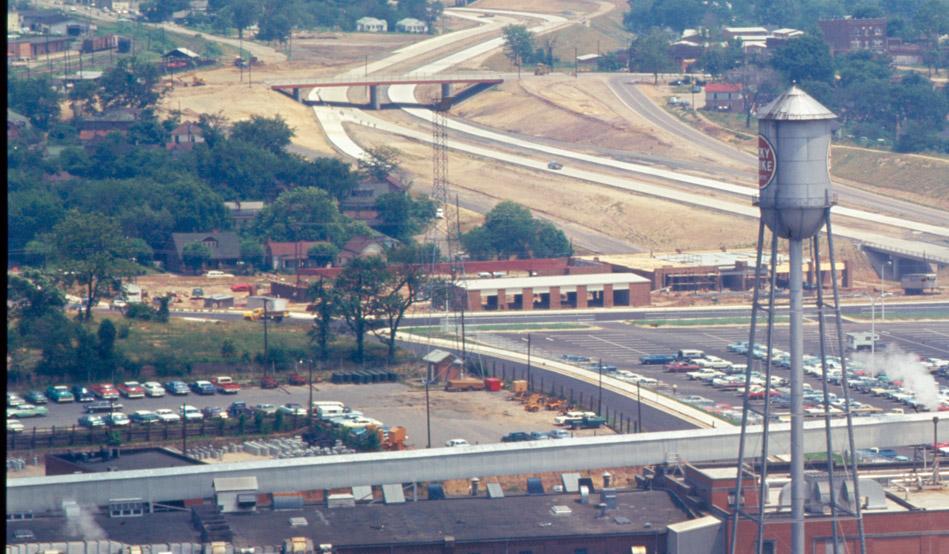

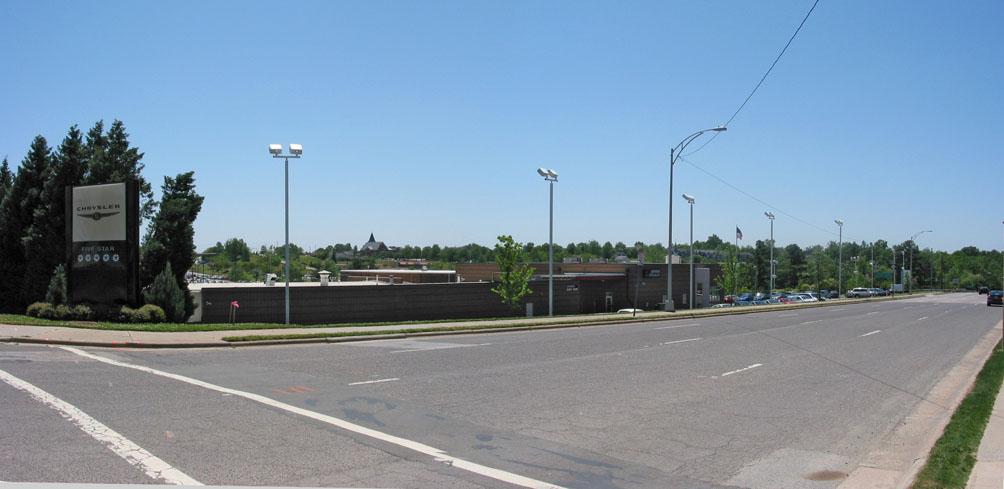
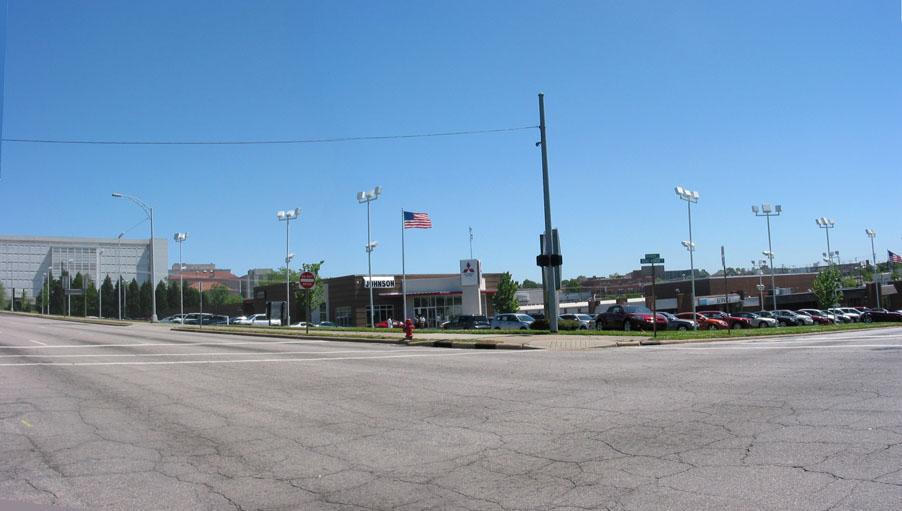
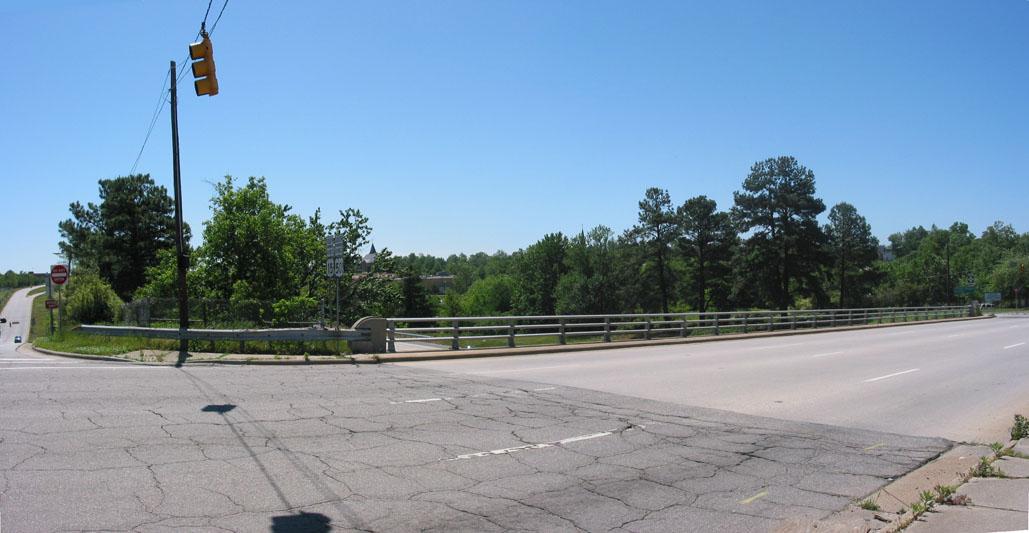
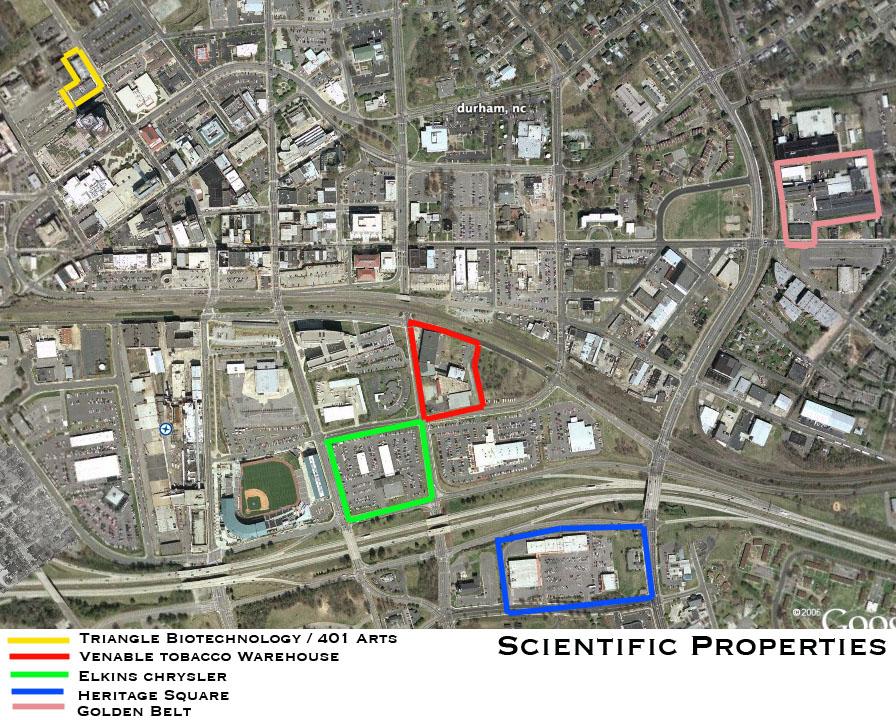
Comments
Submitted by RWE (not verified) on Tue, 6/19/2007 - 11:56pm
Gary,
The majority of your posts seem to include some version of the gut wrenching phrase "all of these properties were torn down by the City using Urban Renewal Funds." I am blown away by the sheer magnitude of federally funded demolition done here in the 60's.
30 seconds of Google research tells me that LBJ's Housing Act of 1965 included $3 billion dollars for "Urban Renewal", which doesn't seem like a lot. Did Durham get all $3 billion or what? Either this city got one heck of a lot of federal money in the 1960's or was uncharacteristically efficient at spending it. Have you seen totals on how much of Urban Renewal money Durham got and how many structures or acres were cleared using it?
Imagine what Downtown Durham might look like if all the tax dollars that were siphoned off to fund LBJ's misguided "Great Society" programs had instead been used to repair aging buildings, upgrade infrastructure and encourage small businesses - or for that matter if it had just been left in the hands of the taxpayers. I can hardly envision a worse use of public moneys than to fund the destruction of a city's cultural and historic resources.
Rob
Submitted by Gary (not verified) on Wed, 6/20/2007 - 12:52am
Rob
Surprisingly, given the devatating effect of urban renewal on the American landscape, there seems to be relatively little scholarship on the topic. It was first authorized in 1949, then again in 1954, 1959, 1961, 1965, and 1968 before transitioning to CDBG funding in the early 1970s. So I think substantially more than $3 billion went into the program (considering that they were constructing housing projects like Few Gardens as well.)
Secondly, there was some degree of local funds that went in as well. Figuring out how much went in would require some intense primary research. Most cities would not have been able to afford the program without the Federal funds. Whether Durham was able to extend the program farther than other areas due to local funds - I don't know.
Some cities did get a disproportionate share of urban renewal funds, which is why some cities creating more massive moonscapes. I don't know if Durham was particularly favored.
Lastly, you certainly have to consider that they really weren't paying all that much for the housing, relatively speaking. These big houses were compensated at ~$5000-$11,000 apiece. And there's economy of scale when you bulldoze blocks at a time...
GK
Submitted by Gary (not verified) on Wed, 6/20/2007 - 1:01am
Rob
I forgot to answer the rest of your post. I don't know how many acres were cleared. I've scanned about 600-700 photos, and have a few hundred more to go. So I'm going to guess about 1000 structures. Since most were detached housing, I'm going to guess an average acreage in the 0.1 to 0.2 range. So let's guess about 100 to 200 acres.
Agreed, although you have to start the blame really with Hoover and Truman. I imagine an alternative present for Durham all the time - when I'm not envisioning an alternative future to a rising tax rate to help fund the destruction of the city's cultural and historic resources.
GK
Submitted by RWE (not verified) on Wed, 6/20/2007 - 4:15am
It seems like an inordinate amount of our tax dollars are spent trying to undo ills achieved with our parents' and grandparents' tax dollars. From poorly-conceived programs like the ones that funded all this demolition, to those across the nation that straightened and paved riverbeds and drained wetlands (which of course now need federally subsidized un-straightening and re-flooding) it is a dizzying spiral of governmental buffoonery.
It makes me think about the various boneheaded legacies we could be visiting upon our grandchildren. Will they wonder what the heck we were thinking when we spent millions of dollars ripping out our railroads and manufacturing infrastructure to build fitness trails and cool loft apartments?
Thanks again for all of your research and hard work here. As painful as it is to read sometimes, I just can't look away.
Rob
Submitted by Anonymous (not verified) on Wed, 6/20/2007 - 2:19pm
It reminds me of that line in that song by Mike and the Mechanics that I can't stand - "Every generation, blames the one before..."
We can't undue the past. The problem with the present is that we still lack the leadership on the local, state and national level that is needed to make urban design and planning a top priority. In most places, (including Durham) despite some better tools, it is still an afterthought. I think we are doing just as much damage to our city now by building cheap, throw-away structures and creating vast suburban wastelands as we did when we were tearing down our urban core in the 60s and 70s. It's not too hard anymore to envision our downtown being infilled and revitalized, but what are we going to do with places like Southpoint in 30 years when it is run-down and obsolete? I guess we won't care because it will be somebody else's problem. I personally would like to leave a place better than when I found it. Unfortunately, this idea is only shared by the handful of hopeless romantics who read your post.
Submitted by Gary (not verified) on Wed, 6/20/2007 - 3:05pm
Anon
I agree - blaming is useless unless you articulate an alternative - which is what I try to do. The most important piece of studying the past, to me, is to realize that the people who envisioned and implemented these programs were not, for the most part, 'bad' people or dumb people. Rather, they were, generally, people who thought they were saving cities, lifting people from poverty and slums, creating 'progress' that would lift all boats, etc., etc.
To me this is crucial to understand - because some of the worst excesses in policy are done in the name of good. I blame anyone who promises sweeping positive change without educating themselves as to how such change has failed before, how the system actually functions, and trying to make their best effort to avoid those pitfalls. They may fail anyway, but not for lack of education and preparation.
The most dangerous thing about our current demolition spree in the city is that a large number of people believe that it will 'fix' East Durham, West End, East End, and Southside. If one argues against the policy, one is in favor of keeping people mired in poverty and violence. At worst, one is a racist. This is the recipe for how bad policy gets created - 1) Drape it in the mantle of crusade. 2) Ignore the failures of said policy in the past, because the past is irrelevant - or because the motivation is subtly different. 3) Ignore the evidence from the literature, because the present program is 'different.'
I agree completely about our suburban creation; we already know how difficult it is to find a fitting reuse for a big box store. Again, the belief is firmly cemented in the minds of many that economic growth=horizontal growth. So if you argue against horizontal growth, you are arguing against jobs, etc.
Essentially, I come down to impatience with the notion that the government is the perfect tool to fix problems or the market is the perfect tool to fix problems. They are just systems - each with advantages in some situations and prone to failure in others. I'd be happier if we would at least try to base our assertions on some actual study of how a system has been successful or failed rather than fixed belief systems.
GK
Submitted by Gary (not verified) on Wed, 6/20/2007 - 6:34pm
As it happens, just today, I obtained more info on the urban renewal financing for Durham:
Downtown cost: $16.1 million
All other areas: $10.3 million
Total $26.4 million
Estimated Proceeds from Land Sales: $6.6 million
Net Cost: $19.8 million
City Share: $6.6 million
Federal Share: $13.2 million
GK
Submitted by Anonymous (not verified) on Thu, 6/21/2007 - 2:39pm
Wow. $19.8 million to tear down half of our downtown. It is truly amazing how cheap and quick it is to trash 100 years of a city's history.
Submitted by Anonymous (not verified) on Sun, 6/24/2007 - 12:20am
I think it would be fair for you to mention that at the time these pictures were taken, all these houses had 20 tenants and one toilet.
Submitted by Gary (not verified) on Sun, 6/24/2007 - 3:22am
First Anon
What a bargain, eh?
Second Anon
It'd be great if you could cite a source for that information - doesn't jibe with the information I have from the appraisal records for these houses. But, I'd point out, even if this were true (because there were quite a few rooming houses then, as there are now, knocking down houses doesn't really help overcrowding due to lack of housing, does it? Probably would have made more sense to build more viable housing options (not the projects). Or maybe you think we should we knock down houses in Trinity Park when Duke students cram too many into them in order to afford them?
Submitted by Andrew Edmonds (not verified) on Thu, 6/5/2008 - 9:51pm
The News and Observer reported today (5 June 2008) that the new City Hall design features an 11-story structure with parking deck. Commissioner Heron's comments are a bit puzzling to me, but this should give Andy Rothschile all the latitude he needs to construct a large, and tall, project on the Elkins Chrysler lo just south.
See the links below.
==========
News and Observer
Durham ponders plans for courthouse
Samiha Khanna, Staff Writer
DURHAM - Nothing says "justice" like a courthouse facade propped up by majestic fluted columns.
But straight, square pillars? Maybe not, one county commissioner told designers of plans for the county's new courthouse on Monday.
Board of Commissioners Chairwoman Ellen Reckhow and her counterparts weren't shy about sharing their thoughts on early plans for the county's $100 million project, to open in 2012.
Designers, architects and the general public may do the same over the next two months as county staff and the design company seek public comment.
The facility would hold all court operations, plus the sheriff's office and a parking deck, in a tract filling about half of the block defined by Mangum, Dillard and Roxboro streets.
A hearing in late July will provide the public with the chance to see sketches and ask the designers some questions.
Meanwhile, on Monday, commissioners considered colors, mulled over materials and considered where on the building to put the county seal.
Commissioner Becky Heron emphasized -- repeatedly -- her concerns about how the 11-floor courthouse will look as part of the downtown skyline. "We need to do something to keep it from looking like a hotel," Heron said. She said also that she has heard from lawyers who are concerned about the efficiency of the layout.
So far, designers have spent nearly a year and a half planning the size of the building and how they'll distribute the offices and courtrooms. The nearly 300,000 square feet is more than triple the current judicial building's size, Durham County Engineer Glen Whisler said.
Travis Hicks, a senior designer at O'Brien/Atkins Associates, reviewed the newest renderings and pointed out several signature elements.
A glass-walled stairwell will shoot up one corner of the building, one of several glass components that take advantage of natural daylight.
Other notable features include a grassy plaza where visitors can congregate and employees could take their lunches, Hicks said. A downward-sloping pedestrian bridge would carry parking deck patrons from their cars to the courthouse.
The six-story parking deck at Dillard and Roxboro streets would have at least 900 spaces, Whisler said. Later, the county could expand by two floors, about 300 spots, with proper planning.
==========
Bull City Rising
WUNC's "The State of Things" carried an interesting interview with Andy Rothschild, head of Durham-based Scientific Properties, in its Monday program.
Rothschild confirmed a plan for a large project massing at the site of today's Elkins Chrysler across from Diamond View and the DBAP and next door to the future county courthouse site, noting that the site would include "a new [corporate] headquarters building, and great new tall architecture, the first tall buildings to be built in Durham in a generation." A hotel and residential development are also intended for the site. The mention of Scientific's being the first such new building in a generation can almost be interpreted as an interesting competitive dig at Messrs. Lemanski and Webb, who've also proposed Durham's next tall building for the city center on the Woolworth site.
Add new comment
Log in or register to post comments.